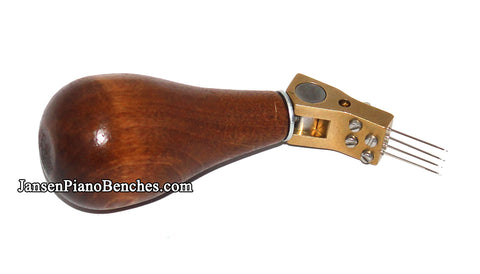What an Examiner in the Piano Technicians' Guild Taught Me about Piano Manufacture
apprenticeship | 09-23-2024 | CharlesOconnell
Posted on 09/23/2024 8:41:03 AM PDT by CharlesOConnell
The worst problem, which prevents a piano from being put perfectly in tune across all "notes", is, for explanation purposes, "growling", lack of each string evoking uniform, neutral harmonics, lack of each string being supported by a bridge which is tangential, 90 degrees, able to be repaired by filing the bridge square when restringing. A tuner can only tune each "note" to a certain level of in-tune-ness, but if this "growling" is afflicting a string, it will never sound perfectly in tune, there will always be a vaguely "out-of-tune" tone. You can listen to various classical performances, to hear which pianos are in proper shape; it's a tragedy when a beautiful performance is marred by a less than perfect instrument
Pianists face challenges getting the sound they want from their instrument. They probably don't understand the technical flaws in their piano. Just knowing the foundations of good piano sound can help them in their playing.
There's a breach between the piano builder and the pianist—if the builder hasn't had sufficient musical education, he will be limited in understanding the musical requirements of the pianist; if the pianist doesn't understand the extensive, but limited technical foundation of the piano as an instrument, their playing will suffer.
A great builder starts by becoming a competent player on an instrument—my master, with whom I had a failed apprenticeship because I didn't have sufficient shop background in school—but he still fully explained the technical part, even if I couldn't master all the crafts—had a BA from a college in a wind instrument, and he has a sideline in acquiring, repairing and maintaining, and recording that instrument.
My master grew up on a real farm, the kind of family farm displaced today by giant ag-businesses. During harvest, if a part on a harvester failed, they couldn't take time to drive 600 miles for a replacement part, they had to have very strong shop skills, to re-manufacture the part. This was the background my master started with.
(This was where I failed—I didn't even take shop in school. An operating engineer had to teach me, "to avoid cross-threading a screw, you turn it backwards until it clicks, then you are at the correct insertion rotation point". I never knew such a thing.)
The environment into which my master entered when starting to independently enter the piano manufacture field, was as follows: when the U.S. entered World War I, there were 300 piano brands in the U.S. alone. This was before radio and sound cinema. Nearly all middle-class homes had a piano of some kind. (Everyone who wasn't deaf or tone-deaf, could "sing" the lyrics to 200 songs, even with a poor voice; there were 10 one-million sellers of sheet music.)
Each of the piano manufacturers had to encompass 11 different secret piano crafts; there are dozens of books which claim to convey these secrets, but they are highly proprietary, and must be independently researched and discovered as traditional crafts. (I mastered piano finishes, because my master had researched and discovered the fundamentals).

After stopping the "growling", (heterodyning, which the Indian instrument Tambura deliberately provokes to cause harmonics to slowly evoke upon which vocalists repose their execution of microtones), the highest piano craft is hammer regulation: making the hammers give out a range of tone from bright to luxuriant. Hammers are shaped with a Dremel tool (I mastered it), sprayed with a thin layer of lacquer, then the master takes a tiny tool with an awl handle, with a business end of a little metal block about 12 mm wide, in which 4 tiny needles are fixed with screws. The master makes the hammer's tone luxuriant or "full bosomed" by softening the hammer, deeply gouging and needling the hammer, which releases some of the tension with which the compressed felt adheres to the wood core. Or, if the tone is to be bright, the master makes the hammer stiffer, by applying any additional, needed lacquer. Mastery of this one of the piano crafts, consists in achieving the required tone across all 88 keys.
The second craft, which my master explained ONCE to me, but I promptly forgot the details, because of my educational insufficiency, is matching the mechanical clockwork "escapement" (like a tiny rachet the lifts off the teeth in a rotating gear once per second). Each key has a complicated array of wooden levers supported by a thick brass button, interposed by tiny felts—properly gluing felts is a whole craft in itself. The goal is for there to be a number of variations in intensity of striking response.
A top model concert grand which sells for $250,000, requires the same amount of technician time to put it in concert shape. Only the instruments which a manufacturer produces on a custom basis, come out of the show room in this condition. If you try to buy a concert instrument, it will have some of the defects described above.
TOPICS: Business/Economy; Music/Entertainment; Science
KEYWORDS: piano; steinway

Hey! FReepers!
Help Fill The Tank!
How About It? Huh?
It Ain't Askin' Too Much
Ya Know....
Click here: to donate by Credit Card
Or here: to donate by PayPal
Or by mail to: Free Republic, LLC - PO Box 9771 - Fresno, CA 93794
Thank you very much and God bless you.
To: CharlesOConnell
2 posted on 09/23/2024 8:44:58 AM PDT by xoxox
To: CharlesOConnell
I used to work the houses on the beach and always wondered about the piano on “Two and a Half Men” my customers said the salt water messed with their pianos.
3 posted on 09/23/2024 8:45:01 AM PDT by ansel12 ((NATO warrior under Reagan, and RA under Nixon, bemoaning the pro-Russians from Vietnam to Ukraine.))
Disclaimer: Opinions posted on Free Republic are those of the individual posters and do not necessarily represent the opinion of Free Republic or its management. All materials posted herein are protected by copyright law and the exemption for fair use of copyrighted works.
FreeRepublic.com is powered by software copyright 2000-2008 John Robinson

 By Free Republic | Created at 2024-09-23 15:48:50 | Updated at 2024-09-30 13:34:30
6 days ago
By Free Republic | Created at 2024-09-23 15:48:50 | Updated at 2024-09-30 13:34:30
6 days ago


